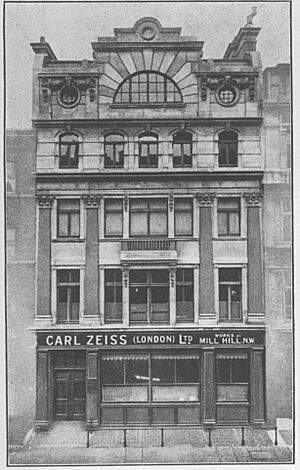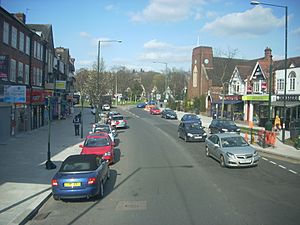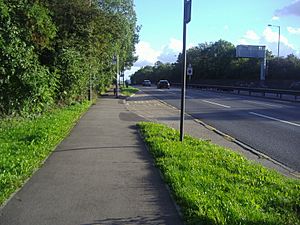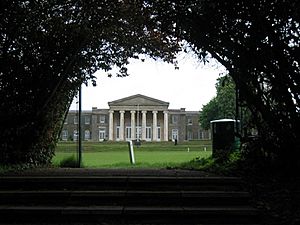Mill Hill facts for kids
Quick facts for kids Mill Hill |
|
|---|---|
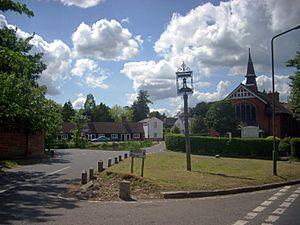 A sign marking Mill Hill Village |
|
| Population | 18,451 (2011 Census, ward) |
| OS grid reference | TQ225925 |
| • Charing Cross | 9 mi (14.5 km) SSE |
| London borough | |
| Ceremonial county | Greater London |
| Region | |
| Country | England |
| Sovereign state | United Kingdom |
| Post town | LONDON |
| Postcode district | NW7 |
| Dialling code | 020 |
| Police | Metropolitan |
| Fire | London |
| Ambulance | London |
| EU Parliament | London |
| UK Parliament |
|
| London Assembly |
|
Mill Hill is a lively area in London, England. It's about 9 miles (14 km) northwest of the very center of London, called Charing Cross. Mill Hill used to be part of Middlesex, an old county. But in 1965, it became part of Greater London. In 2011, about 18,451 people lived here.
Mill Hill has a few different parts. There's the original Mill Hill Village, which is the oldest area. Then there's Mill Hill Broadway, which grew later and is now the main shopping and transport hub. You'll also find Mill Hill East and lots of open countryside. A small part called The Hale is shared between Mill Hill and Edgware.
Contents
Mill Hill's Past
The name "Mill Hill" was first written down in 1547. It likely means "hill with a windmill." The original mill was near a park called The Mill Field.
Mill Hill Village: The Oldest Part
Mill Hill Village is the oldest part of the area where people have lived. It grew along an old road from the Middle Ages called 'The Ridgeway'. People think the name 'Mill Hill' came from a windmill on The Ridgeway. This mill was on an open field, which is now a park called The Mill Field.
The village is surrounded by Green Belt land, which means it's protected from too much building. Its High Street is only about 100 yards long, making it the shortest in London! Because it was close to the city, many people used Mill Hill as a country escape from the 1600s onwards. You can still see large old houses and cute cottages.
Famous people like William Wilberforce, who helped end the slave trade, and Sir Stamford Raffles, who founded Singapore, lived here for a short time. Wilberforce even supported Mill Hill's first church, Saint Paul’s. Years ago, the Village had five shops, but now they are all houses. Today, you can only spend money at The Three Hammers and Adam & Eve pubs, and at Belmont Farm, which has a Waffle Café.
Military History
Inglis Barracks in Mill Hill East was home to the Middlesex Regiment soldiers from 1905 to 1966. The railway station was reopened in 1941 during wartime to make it easier for soldiers to get to the barracks.
There's also Seafield House on Partingdale Lane. It's now a private home, but it was once a secret nuclear bunker. It was built to protect the emergency government for North London from about 1951 to 1985.
Where is Mill Hill?
Mill Hill's postal code is London NW7. This code also covers part of a nearby area called Arkley.
Mill Hill Village Area
The village follows 'The Ridgeway' road. It has protected green land on both sides.
"Partingdale" and "Burtonhole" are valleys north of The Ridgeway. Further north are Folly Farm and Folly Brook, a small river that flows into Dollis Brook. Between The Ridgeway and Folly Brook, you'll find the National Institute for Medical Research, Burtonhole Farm, a garden center, and several sports fields.
Arrandene Open Space and Featherstone Hill is a big open area. It has many open fields, meadows, and woodlands. These fields used to grow hay to feed horses pulling carriages to Barnet.
On Milespit Hill, there is Mill Hill Cemetery. The pop singer Billy Fury is buried there. The cemetery also has graves for 53 soldiers from World War II. Plus, there's a special area called The Netherlands Field of Honour, with graves for over 250 Dutch servicemen.
Southwest of Mill Hill Village is a small area called "Poets' Corner." To the north, there's an old estate that is now a nature reserve, Moat Mount Open Space.
Mill Hill Broadway: The Main Hub
The main part of Mill Hill today is Mill Hill Broadway. It used to be called Lawrence Street. This area grew a lot from the 1890s, especially after the Midland Railway station opened in 1868. Today, The Broadway is a busy shopping area with many shops, cafes, and good transport links.
Mill Hill East: Modern Changes
Some parts of Mill Hill East have been rebuilt recently. For example, an old gas works was replaced by a Waitrose supermarket and new homes. The small shopping area in Mill Hill East is at "Kelly’s Corner," also known as Holders Hill Circus. South of Mill Hill East are Copthall and Holders Hill.
The United Kingdom / Carl Zeiss / Bausch & Lomb Optical Works was built on Bittacy Hill in 1912. It was taken down around 1990. Now, a large building owned by the Jehovah's Witnesses stands there, near their Watchtower House.
Who Lives in Mill Hill?
The Mill Hill area had 18,451 people living there in 2011. Most people (64%) were White. The largest minority groups were Indian (7%), Other Asian (6%), and Black African (6%).
When it comes to religion, 39% were Christian, 19% Jewish, and 12% Muslim. About 14% said they had no religion. Most homes in Mill Hill are owned by the people who live in them. Many of the houses are semi-detached.
Getting Around Mill Hill
Train and Tube Stations
You can find these stations in Mill Hill:
- Mill Hill Broadway Station (on the Thameslink line)
- Mill Hill East station (on the Northern line)
There was another smaller station called Mill Hill (The Hale). It opened in 1867, but passenger trains stopped in 1939. Freight trains stopped in 1964.
The railway line was built in 1867. It included the beautiful Dollis Brook Viaduct east of the station. The line originally went west to Edgware and east to Finsbury Park station.
In 1935, there were plans to update and electrify the railway for the London Underground. Work started, and steam trains stopped in 1939. However, World War II meant the project was cut short. The section from Finchley Central to Mill Hill East was finished in 1941 because it was important for the Inglis Barracks. But plans to finish the line to Edgware were never restarted after the war.
Steam freight trains kept running between Finchley and Edgware until 1964. The tracks beyond Mill Hill East were removed the next year. Even though parts of the old track are now built over, you can still see some unused concrete structures from the 1930s. Most of the old track bed is now a footpath.
Buses
Many London Buses routes serve Mill Hill. These include routes 113, 114, 186, 221, 240, 251, 292, 302, 303, 305, 382, 605, 614, 628, 644, 688, and N113.
Roads
The A1 and A41 roads meet at Fiveways Corner in Mill Hill. This part is called the Watford Way. The dual carriageway goes through Mill Hill, and the roads split again at Apex Corner. The M1 motorway was built through the western part of Mill Hill in 1967. There's a disused exit road that goes under the Watford Way. It covers part of the old railway line between Mill Hill East and Edgware Town.
New Buildings and Plans
The Mayor of London has marked Mill Hill East as an area for more building, especially around the Inglis Barracks site. This means Barnet Council has plans for the area. There were public meetings and discussions about these plans.
Some people wanted the railway line from Mill Hill East station to the west to be reopened. Local people also fought to keep a road called Sanders Lane closed to traffic. The council agreed it would stay closed.
Cool Inventions and Discoveries
In 1749, a botanist named Peter Collinson inherited land that is now part of Mill Hill School. He created a special garden there with many plants.
The famous dictionary maker James Murray started working on the first Oxford English Dictionary in 1879 while teaching at Mill Hill School. He had a special building called a scriptorium built at the school to hold all his notes.
During World War II, the Maudsley Hospital moved to Mill Hill School. Here, a scientist named John C. Raven created a verbal intelligence test called the Mill Hill Vocabulary scale.
The University of London Observatory is in Mill Hill. It's a place where students learn about astronomy. In 2009, student astronomers there tracked a planet outside our solar system, HD 80606 b, and figured out its size for the first time!
The National Institute for Medical Research is a big medical research center on The Ridgeway. Scientists there have made important discoveries, like developing ways to separate chemicals (called liquid and gas chromatography) and finding interferon, a protein that helps fight viruses. They also discovered the gene that determines if someone is male or female, called SRY.
Places of Worship
There are several religious buildings along The Ridgeway:
- The Missionary Institute (until 2007)
- Holcombe House
- The main house for the British Province of the Daughters of Charity of Saint Vincent de Paul
- Saint Joseph's College, a large seminary (until 2007)
- The Jehovah's Witnesses have had a center since 1958. They rebuilt the old Carl Zeiss optical works into the International Bible Students' Association in 1988.
- The Brotherhood of the Cross and Star, an African church, is next to the Village Pond.
- Mill Hill Synagogue is near Mill Hill Broadway station.
- John Keble Church, Mill Hill
Sports in Mill Hill
Old Cholmeleians Sports Ground on Hendon Wood Lane has fields for football and cricket. It's the home of Old Cholmeleians Cricket Club.
The local rugby club is Mill Hill Rugby Football Club, started in 1937. They have two men's teams.
The Mill Hill darts team is based at Mill Hill Services Club. They were the Middlesex Superleague champions in June 2019.
Schools in Mill Hill
Primary Schools
- Courtland (mixed community school)
- Deansbrook Infant (mixed community school)
- Deansbrook Junior (mixed community school)
- Dollis Infant (mixed community school)
- Dollis Junior (mixed foundation school) - now combined with Dollis Infant to form Dollis Primary
- Fairway (mixed community school)
- Grimsdell (independent pre-preparatory school)
- Mathilda Marks Kennedy (mixed Jewish school)
- St. Martin's (independent preparatory school)
- St. Paul's CE (mixed, voluntary aided school)
- St. Vincent's Catholic Primary School
- Etz Chaim Primary School (Free school)
- Millbrook Park Primary School
Secondary Schools
- Copthall School (girls school)
- Mill Hill County High School (mixed foundation school)
Independent Schools
The Mill Hill School Foundation runs these schools:
- Mill Hill School – for students aged 13–18
- Grimsdell – for students aged 3–7
- Belmont School – for students aged 7–13
- The Mount School/ Mill Hill International – for international students aged 11–16
Famous People from Mill Hill
Many well-known people have lived in or are from Mill Hill:
- Racing drivers Graham Hill and his son Damon Hill lived here. Their house has a blue plaque.
- The botanist Peter Collinson and traveler Celia Fiennes lived here.
- Playwright Michael Frayn was born in Mill Hill.
- Actors Patrick McGoohan, Patrick Troughton (who played the second Doctor in Doctor Who), John Slater, Ian Carmichael, and Graham Crowden lived locally.
- Sir Stamford Raffles, who founded Singapore, and William Wilberforce, who fought to end slavery, lived nearby.
- Pop singer Paul Young and songwriter Mitch Murray have lived here.
- Billionaire businessman Mike Ashley lived on Totteridge Lane.
- Pop singer Rachel Stevens from S Club 7 currently lives in Mill Hill.
- The pop group Girls Aloud also lived nearby.
- Actress Angela Lansbury lived in Weymouth Avenue in the 1930s.
- Bandleader Edmundo Ros lived for many years on Page Street.
Images for kids



